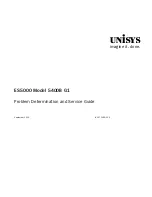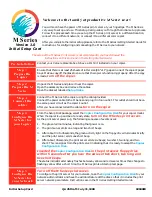
Uninterruptible Power Supply (UPS)
NOTE:
An NS2100 system supports the HPE model R5000 UPS for a single-phase power
configuration and the HPE model R12000/3 UPS for a three-phase power configuration. An
extended run-time module (ERM) can be combined with a UPS to extend battery time.
Modular cabinets do not have built-in batteries to provide power during power failures. To support
system operation and ride-through support during a power failure, NS2100 systems require either
an optional UPS installed in each modular cabinet or a site UPS to support system operation
through a power failure. This system operation support can include a planned orderly shutdown
at a predetermined time in the event of an extended power failure. A timely and orderly shutdown
prevents an uncontrolled and asymmetric shutdown of the system resources from depleted UPS
batteries.
OSM provides this ride-through support during a power failure. When OSM detects a power
failure, it triggers a ride-through timer. To set this timer, you must configure the ride-through time
in SCF. For this information, see the
SCF Reference Manual for the Kernel Subsystem
. If AC
power is not restored before the configured ride-through time period ends, OSM initiates an
orderly shutdown of I/O operations and processors. For additional information, see
NOTE:
Retrofitting a system in the field with a UPS or a UPS/ERM combination will likely
require moving all installed enclosures in the rack to provide space for the new hardware. One
or more of the enclosures that formerly resided in the rack might be displaced and therefore have
to be installed in another rack that would also need a UPS or UPS/ERM combination installed.
Additionally, lifting equipment might be required to lift heavy enclosures to their new location.
For information and specifications on the UPS and ERM that is supported for a single-phase
power configuration, see
and the
HPE UPS R5000 User Guide
at:
http://www.hpe.com/support/UPS_3_Phase_Manuals
For information and specifications on the R12000/3 UPS and ERM that is supported for a
three-phase power configuration, see
and the
HPE 3 Phase UPS User
Guide
at:
http://www.hpe.com/support/UPS_3_Phase_Manuals
If you install a UPS other than the HPE model R5000 or R12000/3 UPS in each modular cabinet
of an NS2100 system, these requirements must be met to ensure the system can survive a total
AC power fail:
•
The UPS output voltage can support the HPE PDU input voltage requirements.
•
The UPS phase output matches the PDU phase input. For information, see
•
The UPS output can support the targeted system in the event of an AC power failure.
Calculate each cabinet load to ensure the UPS can support a proper ride-through time in
the event of a total AC power failure. For more information, see
NOTE:
A UPS other than the HPE model R5000 or R12000/3 will not be able to utilize
the power fail support of the
Configure a Power Source as UPS
OSM action.
IMPORTANT:
You must change the ride-through time for a Hewlett Packard
Enterprise-supported UPS from the manufacturing default setting to an appropriate value for
your system. During installation of an NS2100 system or HPE UPS, your service provider can
refer to the "Setting the Ride-Through Time and Configuring for Maximized Runtime" procedure
in the
NS2100 Hardware Installation Manual
for these instructions.
40
Site Preparation Guidelines for NS2100 Systems
















































